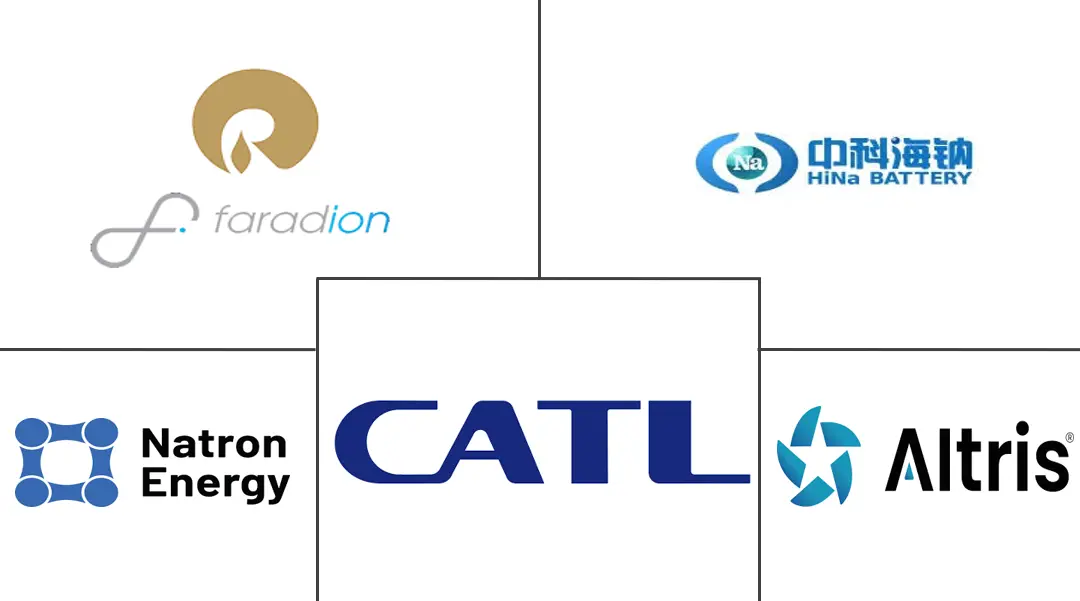Sodium-ion Battery Market Size and Share
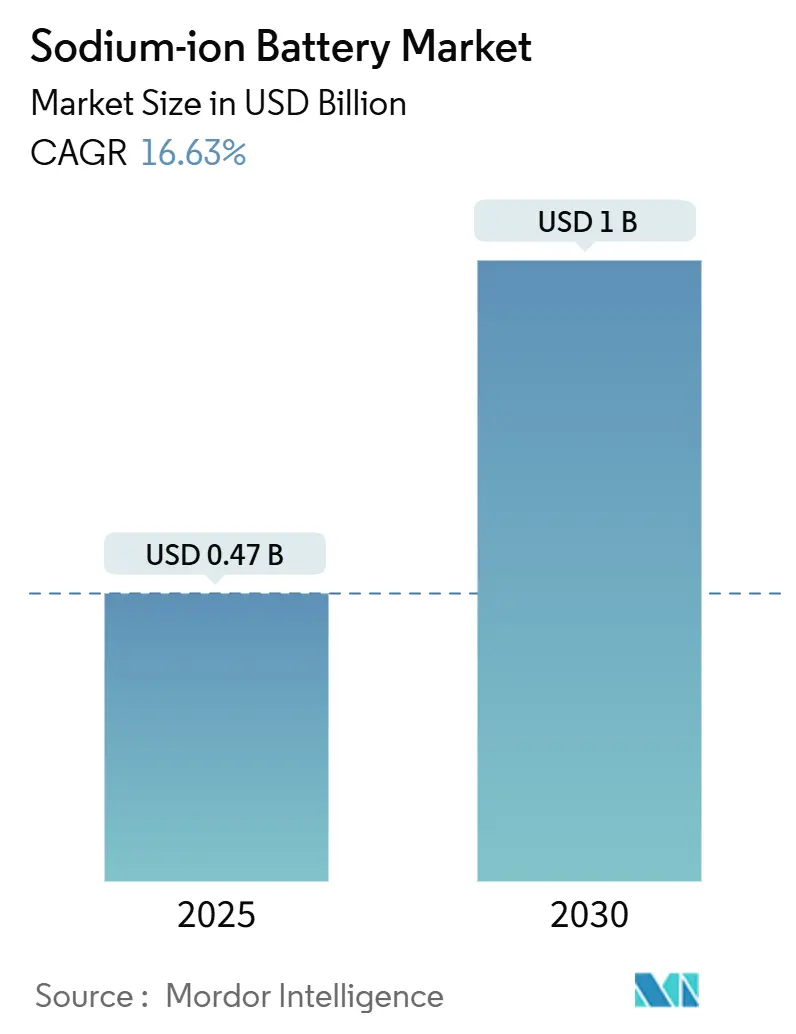
Sodium-ion Battery Market Analysis by Mordor Intelligence
The Sodium-ion Battery Market size is estimated at USD 0.47 billion in 2025, and is expected to reach USD 1 billion by 2030, at a CAGR of 16.63% during the forecast period (2025-2030).
This momentum stems from the growing urgency to diversify beyond lithium-based chemistries, lower pack-level costs now under USD 70/kWh, and the wide availability of sodium resources. Grid operators are accelerating procurement to balance renewable variability. while policy-backed 100 + MWh tenders in China, rapid two-wheeler electrification in India, and cost-focused European EV programs are amplifying demand . The cylindrical cell format, which can be produced on repurposed lithium-ion lines, anchors early volume, yet pouch cells are scaling quickly as form-factor flexibility becomes vital for vehicles and residential storage. Utilities remain the largest buyers because safety, long cycle life, and zero-volt shipping trump energy-density constraints, but transportation applications are advancing fastest as cost advantages outweigh the 30% density penalty in short-range vehicles.
Key Report Takeaways
- By application, stationary storage commanded 72% of the sodium ion battery market share in 2024; transportation is projected to expand at a 20% CAGR to 2030.
- By form factor, cylindrical cells led with 48% revenue share in 2024; pouch cells are forecast to grow at a 21% CAGR through 2030.
- By end-user industry, utilities held 55% share of the sodium-ion battery market size in 2024, while automotive is advancing at a 20% CAGR through 2030.
- By region, Asia-Pacific accounted for 47% of the sodium-ion battery market size in 2024 and is progressing at a 20% CAGR to 2030.
Global Sodium-ion Battery Market Trends and Insights
Drivers Impact Analysis
| Driver | (~) % Impact on CAGR Forecast | Geographic Relevance | Impact Timeline |
|---|---|---|---|
| China’s policy-backed 100 + MWh grid tenders accelerate domestic demand | +4.20% | China, wider Asia-Pacific | Short term (≤ 2 years) |
| European EV OEMs switch low-range models to sodium-ion to meet EU Battery Regulation | +3.80% | Germany, France, UK | Medium term (2-4 years) |
| LFP cathode cost inflation narrows pack-level cost gap below USD 70/kWh | +3.10% | Global focus on China and North America | Short term (≤ 2 years) |
| Prussian-Blue breakthrough enables 15-minute charge for India two-wheelers | +2.50% | India, Southeast Asia | Medium term (2-4 years) |
| Cold-Climate Resilience Spurs Nordic Residential Storage Subsidies | +1.8% | Nordic Countries, with potential expansion to Canada and Russia | Medium term (2-4 years) |
| CATL-Utility Joint-Venture Plants Secure Vertical Supply Chains | +1.1% | China, with expansion to Europe and North America | Long term (≥ 4 years) |
| Source: Mordor Intelligence | |||
China’s Policy-Backed Grid Tenders Transform Market Dynamics
China’s 14th Five-Year Plan features multi-gigawatt procurement rounds that exceed 100 MWh per tender, triggering an unprecedented production ramp across more than 240 GWh of announced sodium-ion capacity. Domestic cell makers are already delivering pack costs 30-40% lower than lithium-ion equivalents, largely by substituting USD 14,000/t lithium carbonate with USD 300/t s odium carbonate and leveraging existing cylindrical-cell tooling. International Energy Agency projections indicate sodium-ion systems could represent 10% of global storage additions within five years, with China retaining roughly 90% of manufacturing volume by 2030(1).
European EV OEMs Embrace Sodium-Ion for Regulatory Compliance
EU Regulation 2023/1542 obliges carmakers to disclose carbon footprints and recycled content through digital passports, pushing OEMs toward chemistries that avoid cobalt and minimize lithium. Sodium-ion packs help compact-segment models satisfy range requirements below 400 km while cutting per-kilometre costs by 21.8% compared with nickel-rich batteries, according to Koloch et al. Laboratory demonstrations of 59 kWh sodium-ion packs achieve 373 km driving range, well inside typical urban-use envelopes(2)Koloch M., “Cost and Range Analysis of Sodium-Ion Batteries for Passenger Cars,” Springer Nature, springer.com.
LFP Cost Inflation Creates a Competitive Opening
Sharp increases in lithium and phosphate prices have squeezed LFP cost leadership, pulling the LFP-to-sodium price delta under USD 70/kWh at pack level. International Energy Agency cost curves show sodium-ion cells reaching up to 30% lower production costs as volumes scale. Because manufacturing lines need only minor process tweaks, the technology can ride existing gigafactory footprints, hastening parity in price-sensitive grid and low-speed mobility applications. Nature Energy analysis by Yao et al. suggests sodium-ion will achieve clear economic advantage if lithium commodity prices stay elevated through 2026(3)Yao Y., “Economic Prospects of Sodium-Ion Chemistries,” Nature Energy, nature.com.
Prussian-Blue Breakthrough Transforms Two-Wheeler Market
Indian Institute of Technology researchers demonstrated 100 mAh/g capacity at 10C rates with 91% retention after 500 cycles using advanced Prussian-Blue analogue cathodes. The chemistry supports 15-minute charging, solving a critical adoption bottleneck for India’s high-volume scooter segment. KPIT Technologies and Trentar are investing in a 3 GWh plant to commercialize the design, positioning sodium-ion as a low-cost, fast-charge alternative in congested urban centres.
Restraints Impact Analysis
| Restraint | (~) % Impact on CAGR Forecast | Geographic Relevance | Impact Timeline |
|---|---|---|---|
| −30% energy-density penalty versus LFP in long-range EVs | -2.80% | North America, Europe | Medium term (2-4 years) |
| Absence of standardised BMS protocols raises integration costs | -1.90% | Global | Short term (≤ 2 years) |
| Nascent Recycling Ecosystem Clashes with EU Battery-Passport Rules | -1.2% | Europe, with potential impact on global exports to EU | Medium term (2-4 years) |
| Metallic-Sodium Deposition Risks in >3.7 V Designs | -0.9% | Global | Short term (≤ 2 years) |
| Source: Mordor Intelligence | |||
Energy-Density Limitations Constrain Market Penetration
Commercial sodium-ion cells deliver 130-160 Wh/kg against 180-200 Wh/kg for LFP, translating into 30% heavier and bulkier packs for equal range. Yao et al. point out this restricts practical vehicle range to under 400 km, forcing OEMs to segment portfolios by chemistry. Laboratory programs targeting 200 Wh/kg are promising yet unlikely to enter mass production before 2027. In the interim, automakers maintain dual-chemistry strategies—sodium-ion for cost-sensitive city models and lithium-ion for premium long-range vehicles.
BMS Protocol Standardization Lags Behind Technology
Sodium-ion voltage profiles and thermal signatures differ markedly from lithium-ion benchmarks, yet no universal battery management system standards exist. Custom algorithms for state-of-charge and state-of-health raise engineering spend by 25% and extend project timelines. The UK’s Faraday Battery Challenge recommends a dedicated standards pathway, noting that harmonised BMS protocols would accelerate deployments in telecoms, data centres, and commercial fleets(4)BSI Group, “Standardisation Needs for Sodium-Ion Battery Management,” bsigroup.com.
Segment Analysis
By Application: Stationary Storage Dominates Early Adoption
Stationary installations controlled 72% of the sodium ion battery market in 2024 thanks to favourable cycle life exceeding 6,000 cycles at 80% retention and low material costs that outweigh modest volumetric penalties. Utilities adopt the chemistry for frequency regulation, renewable smoothing and peak shaving, where durability and fire-safety advantages reduce lifetime operating expenditure. The sodium-ion battery market size for stationary systems is projected to expand at 17% CAGR to 2030 as policy-driven procurement accelerates in China and rising renewables penetration boosts storage demand elsewhere. Industrial backup power and microgrids are emerging niches that benefit from the technology’s zero-volt shipping capability, simplifying transport and installation.
Transportation holds a smaller base today yet posts the fastest anticipated growth, reaching a 20% CAGR between 2025 and 2030. India’s two-wheeler segment, China’s low-speed EV fleets and Europe’s entry-level passenger cars anchor early volumes, confirming that modest range requirements can tolerate the energy-density gap. Consumer electronics applications remain below 5% share but could scale in cost-sensitive devices where every-minute uptime outweighs size penalties. Marine and cold-climate deployments demonstrate compelling low-temperature performance, maintaining 80% capacity at -20 °C compared with 50% for many lithium-ion formats.
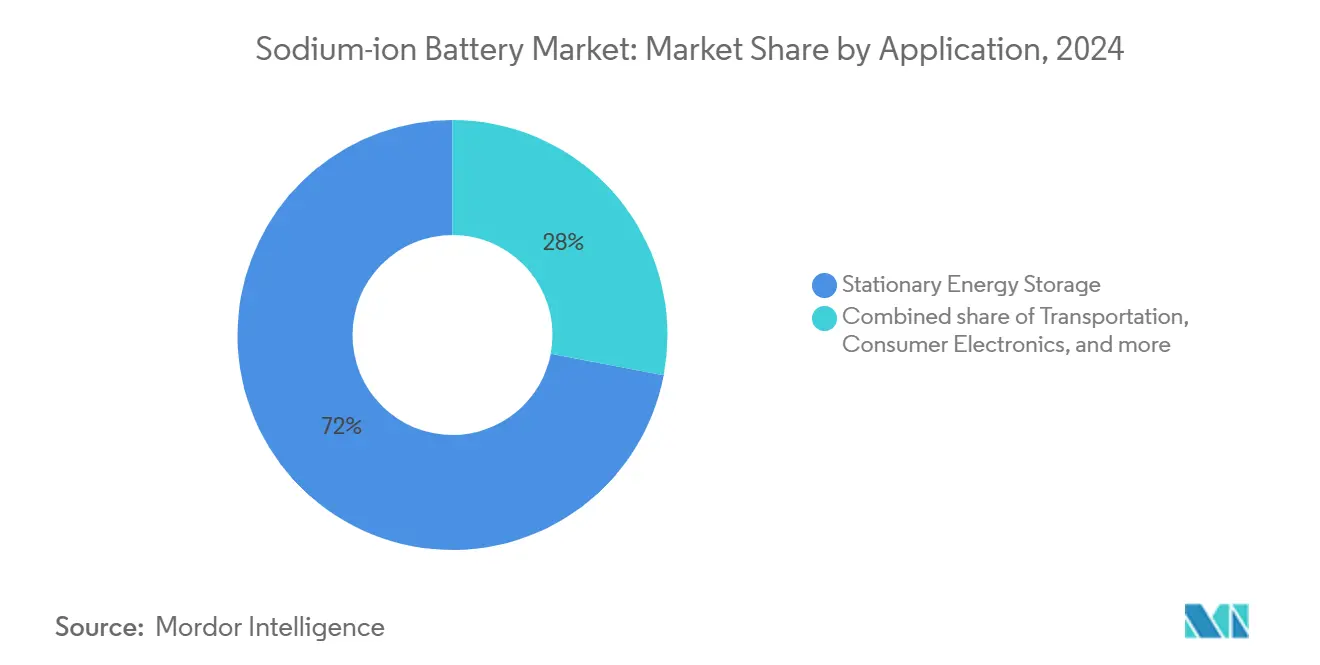
Note: Segment shares of all individual segments available upon report purchase
By Form Factor: Cylindrical Cells Lead Manufacturing Scale-Up
Cylindrical formats accounted for 48% of the sodium ion battery market in 2024 because they slot directly into legacy 18650 and 21700 assembly lines, slashing capital outlay for early movers. Superior heat dissipation and mechanical robustness further suit grid-scale racks that face wide current swings. As a result, the sodium-ion battery market size linked to cylindrical cells is expected to grow steadily even as other form factors gain pace. Prismatic designs currently serve large cabinets where rectangular modules maximize space utilisation and ease cooling duct placement.
Pouch cells, however, are on track for the steepest rise, logging a forecast 21% CAGR through 2030 in the sodium ion battery market. Their 90-95% packing efficiency allows OEMs to offset part of the chemistry’s volumetric shortfall and customize dimensions for scooter footboards, compact passenger cars or wall-mounted residential packs. Recent gas-management breakthroughs mitigate swelling, unlocking high yield rates in pilot lines. Researchers predict that as seal-technology matures, pouch cells will capture a larger share of transportation and consumer devices while cylindrical formats continue to dominate utility arrays.
By End-User Industry: Utilities Lead Strategic Deployment
Utilities represented 55% of total demand in 2024, reaffirming the fit between long-cycle stationary assets and sodium-ion’s safety profile. Frequency response markets pay for millisecond ramp capability, where sodium-ion cells sustain high power pulses without thermal runaway. Analysts see the sodium ion battery market share for utilities remaining dominant through 2030, supported by national storage mandates in China and multi-gigawatt auction programs emerging in India. Residential customers constitute a smaller but rising slice as Nordic subsidies target systems that retain performance at sub-zero temperatures.
Automotive end-use registers the sharpest growth trajectory at 20% CAGR within the sodium-ion battery market, propelled by regulatory advantages in Europe and raw-material security ambitions across Asia. Fleet operators value zero-cobalt content, while bus and delivery-van markets weigh lifetime cost over peak gravimetric energy. Commercial and industrial campuses begin to adopt sodium-ion strings for demand-charge management and fire-zone compliance, particularly where lithium-ion restrictions tighten. Sector specialists expect additional upside once unified BMS standards lower integration overheads.
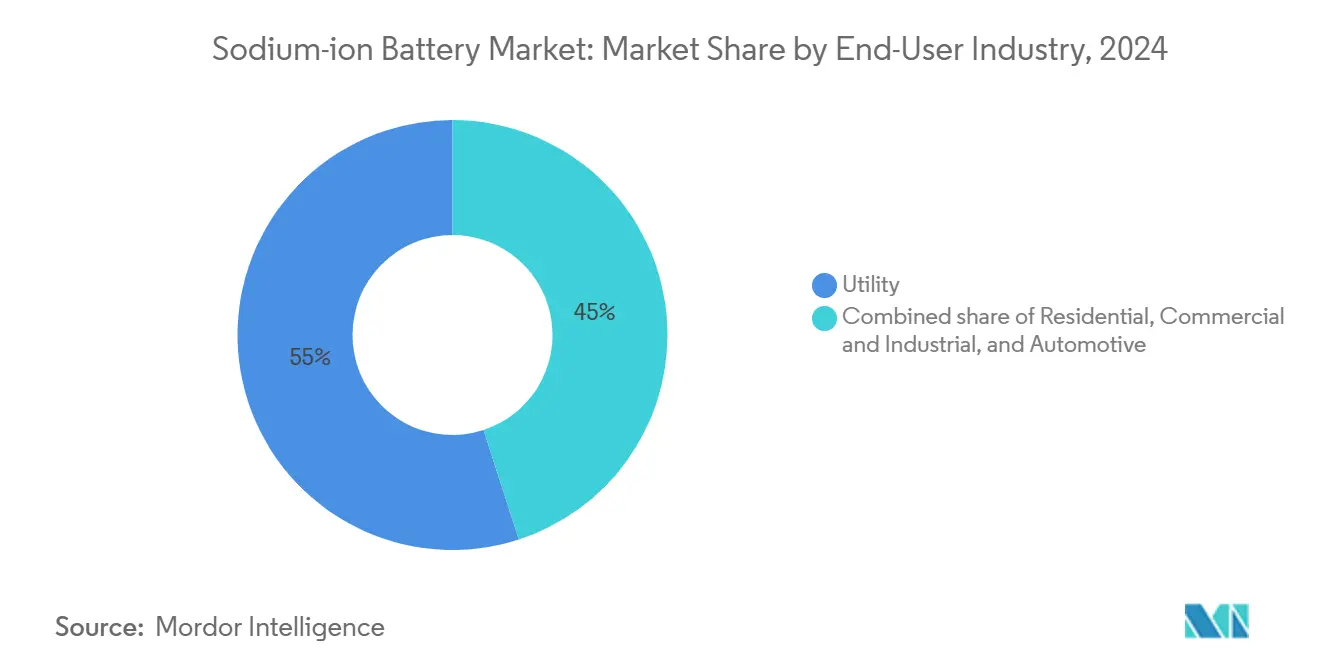
Note: Segment shares of all individual segments available upon report purchase
Geography Analysis
Asia-Pacific holds a commanding 47% sodium ion battery market share and remains the fastest-expanding region at a projected 20% CAGR to 2030. China’s vertically integrated ecosystem covers refined sodium carbonate, Prussian-Blue cathodes and high-volume cell lines—in turn underpinning sub-USD 70/kWh packs for grid projects and electric scooters. India is scaling 3 GWh of domestic capacity oriented to two-wheelers and rooftop storage, while Japan and South Korea experiment with high-voltage electrolytes aimed at industrial robots and marine power trains. Regional policies that prioritise mineral independence from lithium and cobalt continue to anchor investment.
Europe captures around one-quarter of global demand, shaped by regulatory pull rather than raw material push. The EU Battery Regulation embeds lifecycle footprint metrics into product approvals, driving OEMs to slot sodium-ion into affordable city-car segments and stationary assets that feed renewable build-out. Nordic programmes subsidise home batteries rated for -30 °C climates, validating the chemistry’s low-temperature resilience. Germany, France and the UK run pilot lines pairing sodium-ion modules with solar rooftops and rail electrification corridors, reinforcing the region’s broader industrial-strategy goals.
North America commands roughly one-fifth of the sodium ion battery market share, with emphasis on grid-scale safety, critical-mineral resilience and data-center uptime. A USD 1.4 billion plant underway in North Carolina will mass-produce Prussian-Blue cells for telecom and renewable integration, marking a shift from pilot to commercial stage. Canadian utilities deploy sodium-ion banks in remote microgrids where diesel logistics inflate costs and winter temperatures sap lithium-ion performance. Mexico seeks to attract module assemblers close to United States buyers, leveraging trade agreements and existing automotive supply chains.
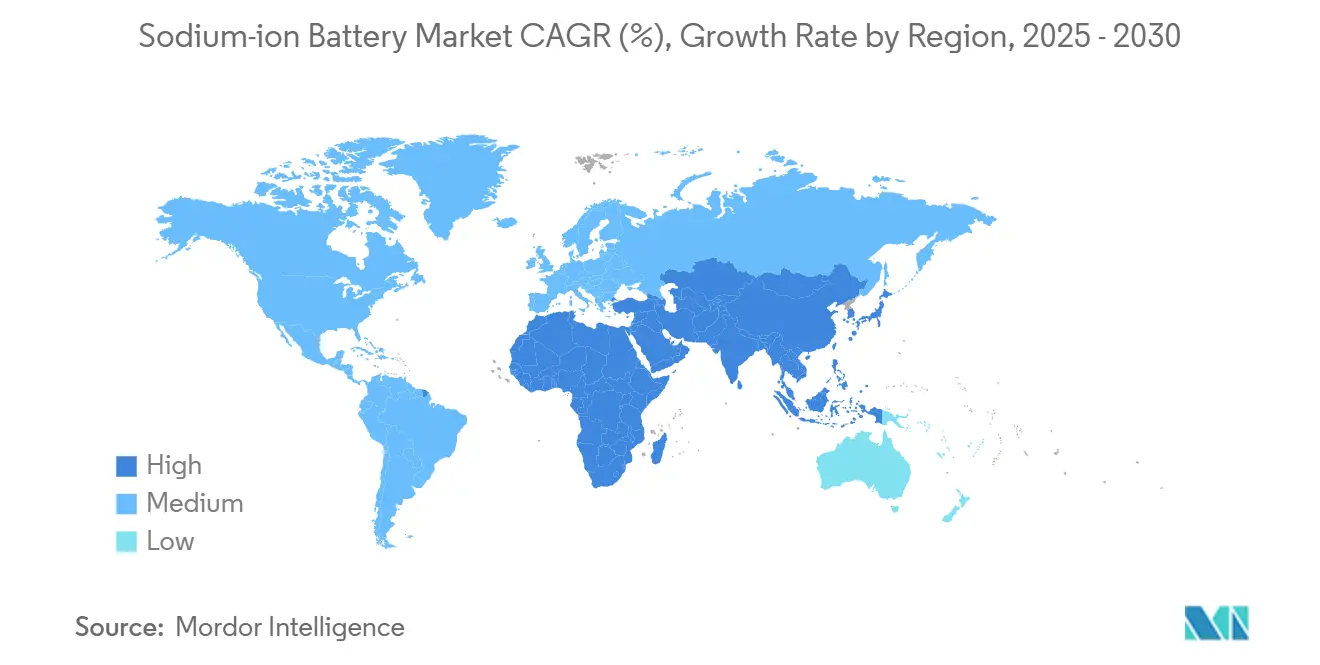
Competitive Landscape
The sodium ion battery market blends established lithium-ion giants and specialist newcomers, yielding a moderately concentrated structure. Chinese leaders such as CATL and BYD apply gigafactory muscle to deliver second-generation sodium-ion packs at 175 Wh/kg and cold-crank ratings down to -40 °C, while European players Northvolt and Altris combine proprietary cathodes with in-house manufacturing know-how to localise supply for EU carmakers. Fast-charge specialist Natron Energy focuses on Prussian-Blue electrode architecture that accepts 10 C bursts, serving data centres and telecom switching gear that prize uptime over volumetric efficiency.
Patent analysis by Iberdrola shows more than half of global sodium-ion filings originate in China, yet substantial portfolios also arise in Japan and the United States, suggesting geographic dispersion of know-how despite China’s scale advantage. Vertical collaboration is intensifying: cell producers sign long-term offtakes with renewable developers and utility EPC firms to lock pricing under multi-gigawatt frame agreements. Software-centric firms eye opportunities in sodium-ion-specific BMS modules, an arena not yet dominated by legacy automotive suppliers.
Barriers to entry remain lower than for high-nickel lithium chemistries because existing electrode coating and calendering equipment can be reused; nevertheless, securing high-purity sodium salts and proprietary carbon anodes differentiates early movers. Industry observers anticipate selective consolidation once gigafactory utilisation reaches steady-state and margin compression rewards scale. For now, a fluid ecosystem of material innovators, integrators and OEMs cooperates under joint-development agreements to accelerate commercial readiness across grid, mobility and consumer segments.
Sodium-ion Battery Industry Leaders
-
Faradion Limited
-
HiNa Battery Technology Co. Ltd.
-
Contemporary Amperex Technology Co. Limited
-
Altris AB
-
Natron Energy Inc.
- *Disclaimer: Major Players sorted in no particular order
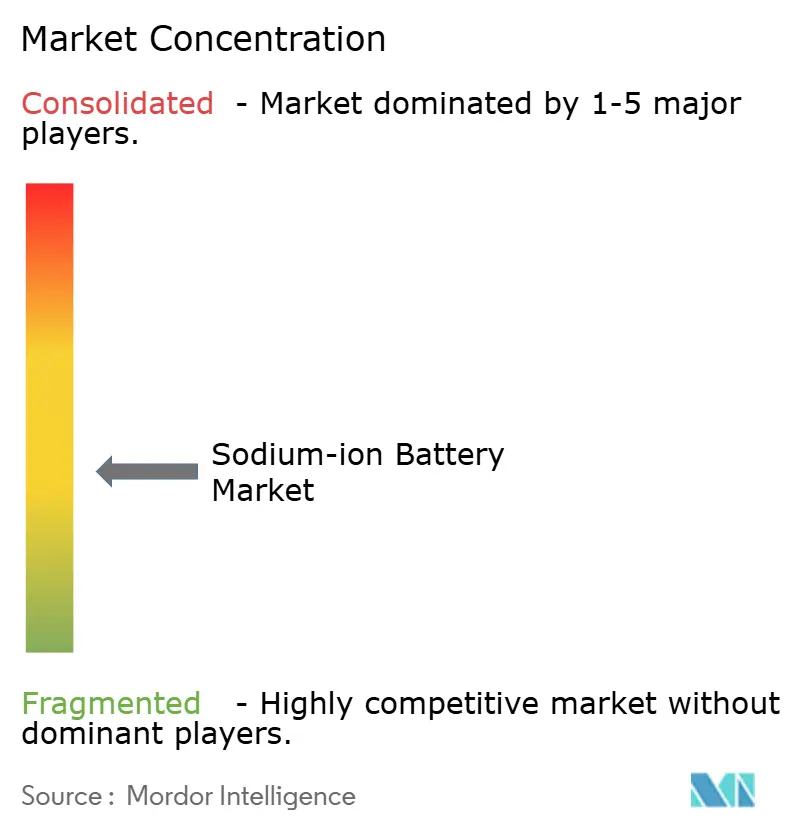
Recent Industry Developments
- April 2025: CATL unveiled its new sodium-ion battery brand “Naxtra” with an energy density of 175 Wh/kg, set to enter mass production in December 2025.
- February 2025: Trentar Energy Solutions partnered with KPIT Technologies to commercialise sodium-ion batteries in India through a 3 GWh manufacturing commitment targeting electric two-wheelers.
- November 2024: BYD launched a sodium-ion grid-scale BESS with 2.3 MWh capacity per 20-foot container, aimed at stationary projects that prioritise cost and longevity.
- August 2024: Natron Energy secured a USD 1.4 billion investment to construct a sodium-ion factory in North Carolina focused on Prussian-Blue cells for data centres and renewable storage.
Research Methodology Framework and Report Scope
Market Definitions and Key Coverage
According to Mordor Intelligence, we define the sodium-ion battery market as all room-temperature rechargeable cells in which sodium ions shuttle between layered oxide or Prussian-blue cathodes and hard-carbon or similar anodes, delivered in cylindrical, prismatic, or pouch form and sold for stationary energy storage, transportation, industrial backup, and consumer devices. Our study tracks factory shipments, revenues, and average selling prices from 2020 through 2030.
Scope Exclusion: We exclude high-temperature molten-salt sodium-sulfur systems and early-stage hybrid chemistries that are not yet commercially shipped.
Segmentation Overview
- By Application
- Stationary Energy Storage
- Transportation
- Consumer Electronics
- Industrial Backup Power
- Marine and Others
- By Form Factor
- Cylindrical
- Prismatic
- Pouch
- By End-User Industry
- Utility
- Residential
- Commercial and Industrial
- Automotive
- By Geography
- North America
- United States
- Canada
- Mexico
- Europe
- United Kingdom
- Germany
- France
- Spain
- Nordic Countries
- Russia
- Rest of Europe
- Asia-Pacific
- China
- India
- Japan
- South Korea
- ASEAN Countries
- Rest of Asia-Pacific
- South America
- Brazil
- Argentina
- Colombia
- Rest of South America
- Middle East and Africa
- United Arab Emirates
- Saudi Arabia
- South Africa
- Rest of Middle East and Africa
- North America
Detailed Research Methodology and Data Validation
Primary Research
Mordor analysts interview sodium-ion cell makers, ESS integrators, EV drivetrain engineers, and regional energy-policy officials across Asia-Pacific, Europe, and North America. These conversations validate capacity utilization, emerging demand pools, and price road maps that secondary data alone cannot capture.
Desk Research
We start with public datasets from bodies such as the International Energy Agency, U.S. Energy Information Administration, EUROBAT, China's MIIT, and Eurostat, which give production, trade, and deployment signals. Company 10-Ks, investor decks, patent filings screened through Questel, and grid-storage tenders pulled via Tenders Info help us benchmark cost curves and project pipelines. D&B Hoovers, Dow Jones Factiva, and peer-reviewed journals then anchor supplier revenues, cathode breakthroughs, and policy timelines. This list is illustrative; many other sources are consulted to cross-check figures and fill smaller gaps.
Market-Sizing & Forecasting
Our model begins with a top-down reconstruction of global sodium-ion demand by mapping installed stationary storage (MWh) and entry-level EV production, then applying chemistry-specific penetration rates. Select bottom-up roll-ups of major suppliers' shipment disclosures and sampled ASP x volume checks test and adjust totals. Key variables include sodium carbonate feedstock cost trends, average cell energy density, policy-linked storage targets, sub-1 MWh community microgrid tenders, and EV battery-pack size migration. Multivariate regression projects each variable to 2030. Gaps where supplier data are missing are bridged with region-weighted industry averages reviewed during expert calls.
Data Validation & Update Cycle
Before release, our analysts rerun anomaly checks, reconcile currency conversions, and obtain a second sign-off from a senior reviewer. The model refreshes annually, with interim updates if policy shifts or capacity announcements move the baseline.
Why Mordor's Sodium ion Battery Baseline Is Highly Credible
Published estimates often differ, and we acknowledge that methodology, scope, and update cadence drive these gaps. Some outlets mix molten-salt NaS units with room-temperature cells, others roll announced capacity into revenue too early, and a few freeze exchange rates for the whole horizon; such choices shift totals materially.
Key gap drivers include inclusion of high-temperature chemistries, counting contracted but undelivered projects, and assuming aggressive price erosion without supplier confirmation, whereas Mordor keeps to shipped volumes, validated ASP paths, and yearly currency re-baselining.
Benchmark comparison
| Market Size | Anonymized source | Primary gap driver |
|---|---|---|
| USD 0.47 B (2025) | Mordor Intelligence | - |
| USD 0.67 B (2025) | Global Consultancy A | Includes NaS cells and pipeline capacities |
| USD 1.47 B (2024) | Industry Journal B | Applies blanket ASP decline and mixed chemistry scope |
| USD 0.37 B (2024) | Trade Journal C | Uses export value only, omits domestic deployments |
The comparison shows that when scope is tightened to commercial room-temperature cells and prices are grounded in supplier disclosures, Mordor delivers a balanced, transparent baseline that decision-makers can confidently trace back to explicit variables and repeatable steps.
Key Questions Answered in the Report
What is the current size and projected growth rate of the sodium ion battery market?
The market stands at USD 465.21 million in 2025 and is forecast to reach USD 1,003.92 million by 2030, advancing at a 16.63% CAGR.
Which application segment leads sodium-ion battery demand?
Stationary energy storage holds 72% of 2024 revenue, while transportation is the fastest-growing use case at a 20% CAGR through 2030.
Why are utilities adopting sodium-ion batteries over lithium-ion solutions?
Utilities value lower pack costs, safer thermal behavior, more than 6,000 cycle life and the ability to ship cells at zero volts.
How do energy-density limits affect sodium-ion use in electric vehicles?
Cells deliver roughly 30% less energy than LFP, so automakers restrict them to city cars and two-wheelers with ranges under 400 km.
Which regions invest most heavily in sodium-ion battery production?
Asia-Pacific commands 47% of global demand, led by China’s 240 GWh pipeline; Europe and North America follow with regulatory and R&D support.
What cost advantage do sodium-ion batteries offer versus LFP packs?
With the pack-level gap now below USD 70/kWh, sodium-ion units can be produced up to 30% cheaper as volumes scale.
Page last updated on:
